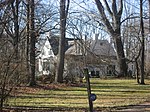Highlandtown Lake
Highlandtown Lake is a man-made lake located in Washington Township, Columbiana County, Ohio. It was created in 1966 when the State of Ohio built a dam impounding 170 acres (0.69 km2) of water on the upper drainage of the Little Yellow Creek. A lot of habitat improvement was done on what would be the bottom of the lake prior to the impoundment. It has about 5 miles (8.0 km) of shoreline and a maximum depth of about 26 feet (7.9 m). The lake is about 1,100 feet (340 m) above sea level. The dam is of earthen construction, rock fill. Its height is 44 feet (13 m) with a length of 1,476 feet (450 m). Maximum discharge is 4196 cubic feet per second. Its capacity is 5,710 acre-feet (0.00704 km3). Normal storage is 2,700 acre-feet (0.0033 km3). It drains an area of 5.8 square miles (15 km2).
Excerpt from the Wikipedia article Highlandtown Lake (License: CC BY-SA 3.0, Authors).Highlandtown Lake
Hedgerow Road,
Geographical coordinates (GPS) Address Website Nearby Places Show on map
Geographical coordinates (GPS)
| Latitude | Longitude |
|---|---|
| N 39.573055555556 ° | E -84.743333333333 ° |
Address
Hueston Woods State Park
Hedgerow Road
45003
Ohio, United States
Open on Google Maps








